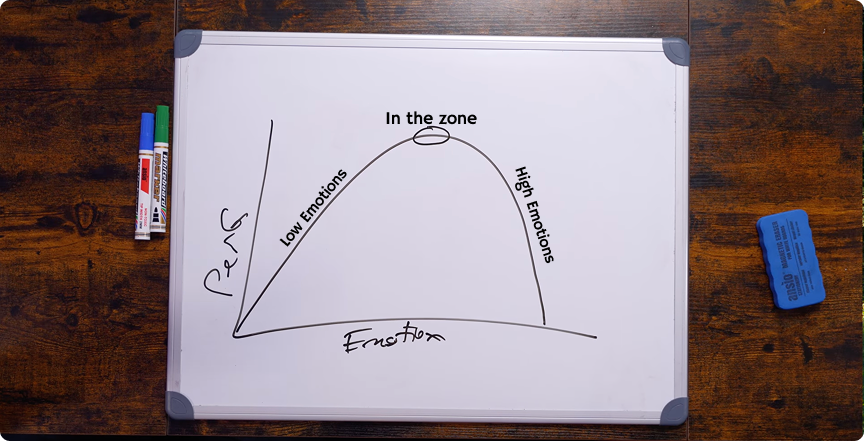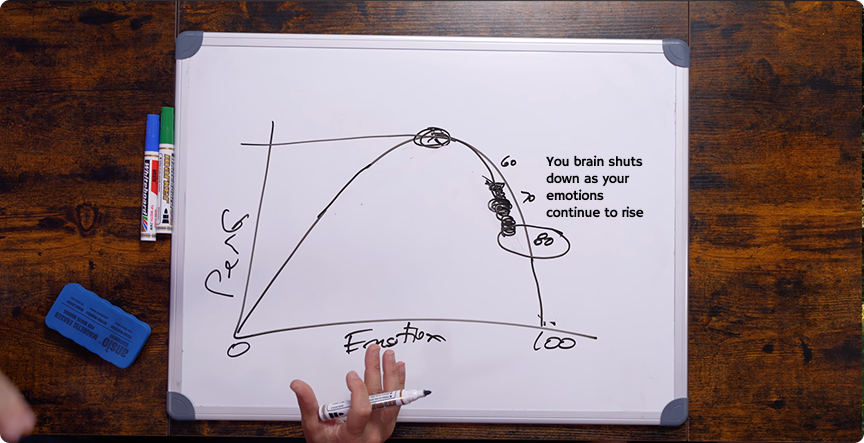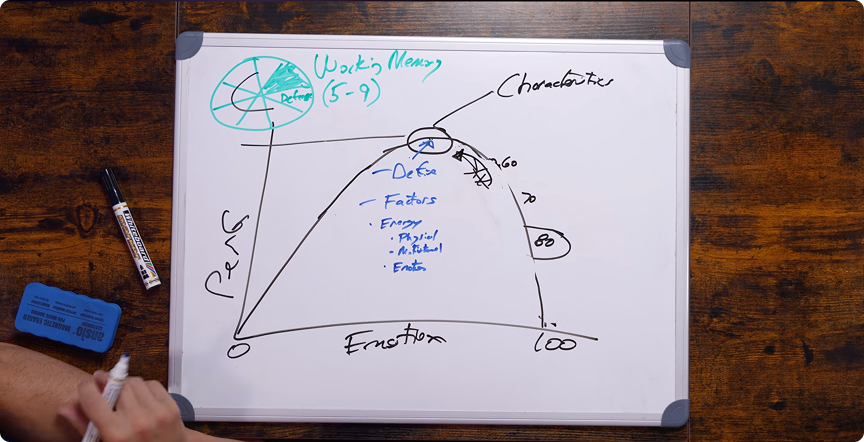You can have the best trading strategy in the world — perfect entries, smart risk management, a solid plan, but if your mind isn’t working properly, none of it matters.
In this masterclass with trading psychologist Jared Tendler, author of The Mental Game of Trading, he explains why most traders fail not because of strategy, but because of a malfunctioning mind.
This guide breaks down the core ideas Jared shared — the link between emotion and performance, how your brain “shuts down” under stress, and practical steps to stay in the zone more often.
By the end, you’ll understand exactly how to control your emotions, recover faster after tough trades, and build the mental consistency that separates great traders from everyone else.
The Hidden Link Between Emotion and Performance
Most traders believe the best traders are emotionless — calm, robotic, and completely detached. But Jared Tendler says that idea is wrong.
Emotion isn’t your enemy. In fact, it’s what powers your brain. You need emotion to focus, plan, and make good decisions.
Without enough emotion, your brain doesn’t have the energy it needs to perform.
The key is to find the right amount — not too much, not too little.
Psychologists call this the Yerkes–Dodson Law.
It shows an upside-down U-shaped curve that explains how emotion affects performance:
- On the left side, too little emotion means you feel flat, tired, or disconnected. You hesitate, miss opportunities, and your mind feels dull.
- In the middle, you have the right balance. You’re focused, confident, and alert. This is your peak performance zone — what Jared calls being “in the zone.”
- On the right side, too much emotion causes your brain to malfunction. Anger, greed, fear, or excitement take over, and discipline disappears.

You don’t need to be emotionless — you need to learn how to stay in that sweet spot in the middle.
What It Feels Like to Be “In the Zone”
Every trader’s zone feels a bit different. Some traders feel calm, steady, and quiet — almost like their heart rate barely moves.
Others feel sharp, active, and intensely focused. Both are fine, as long as you’re balanced.
When you’re in the zone:
- Your mind feels clear and quiet — no overthinking, no noise.
- Decisions flow easily, without hesitation or fear.
- You’re in sync with the market, noticing setups before they form.
- You feel steady, not overexcited or anxious.
The goal isn’t to feel perfect every day. The goal is to understand what your version of the zone looks and feels like — so you can find it more often.
The Progressive Shutdown — Why Awareness Isn’t Enough
Most traders don’t go from calm to chaos in one moment. It happens gradually — like sliding down a hill.
You might start your session fine. Then:
- You miss an entry by one tick.
- A trade reverses just before target.
- You get chopped up a few times in a row.
Each small frustration builds emotional pressure. At first, you still think clearly. But as emotion rises, your thinking brain slowly starts shutting down.
The emotional system becomes more active, and the logical part of the brain (the frontal lobe) begins to lose control. This is why you can be aware that you’re making a mistake — yet still do it anyway.
At around 80% emotion, you still know what’s happening but can’t stop it.
It’s like watching yourself drive toward a cliff but not being able to hit the brakes.
That’s what Jared calls the malfunctioning mind — when your emotional system has taken over your thinking system.

How Emotional Carryover Affects the Next Day
Emotions don’t reset overnight. Even if you slept well, exercised, or told yourself “today’s a new day,” yesterday’s frustration doesn’t magically disappear.
It becomes accumulated emotion — a hidden layer of tension that raises your emotional baseline.
So when you start trading the next morning, you might already be partway up the curve. It takes less to push you into frustration or tilt.
You might not even notice it — you feel normal, maybe even optimistic — but deep down, your system is already charged.
The fix? Awareness and journaling.
Notice when you feel even slightly “off.” Write it down. Treat emotional baggage like leftover risk — if you don’t clear it, it compounds.
Your “Fuel Mix” — What Powers Performance
Your performance every day depends on your energy mix — the blend of physical, motivational, and emotional energy you bring to the market.
- Physical energy comes from sleep, nutrition, and exercise. A bad night’s sleep doesn’t ruin your trading day, but it makes balance harder.
- Motivational energy comes from your goals. If you’re only motivated by “making money,” that fades quickly. Real motivation comes from growth and mastery.
- Emotional energy is how charged you feel — calm, nervous, excited, or frustrated.
Some days, you’ll need to calm yourself down. Other days, you’ll need to wake yourself up. There’s no single routine that works for everyone; it’s about learning what your ideal balance looks like and adjusting it daily.
Working Memory and Clarity of Mind
He introduced the concept of working memory, the mental space where your brain holds and processes information while you’re trading.
The average person can hold about seven pieces of information at once.
When you’re in the zone, that capacity expands — you can hold more information and see patterns faster.
But when your emotions rise too high, your working memory shrinks. You lose that mental space.
Part of it gets taken up by defense — your mind trying to calm itself down — which leaves less space for actual analysis.
That’s why you stop seeing the market clearly and make impulsive decisions.
Correlation vs. Causation — Don’t Fool Yourself
Many traders think, “I traded great after walking my dog — walking must help me trade well!”
But that’s correlation, not causation.
The walk itself didn’t make you trade better — it’s the effect it had (maybe it cleared your head or raised your energy).
When you study your habits, look for the real cause behind what helps.
Be a detective. Ask, “What about this routine actually improves my state?” That’s how you build a reliable pre-market process.
Why Your Brain “Clogs” When You’re Emotional
Your brain’s working memory, the part that holds and processes information, is like a small desk. When you’re calm, that desk is clean and organized. You can think clearly, see multiple ideas, and connect them easily.
But when you get emotional:
- Your desk shrinks — you can’t hold as many thoughts at once.
- Part of it gets taken up by emotion — thoughts like “I can’t believe I missed that!” or “I need to get it back!” fill the space.
- Another part is used for defense — trying to calm yourself or fix mistakes.
This is why clarity disappears when emotions rise. You literally have less brain space to think. You start forcing trades, ignoring context, or missing details that were obvious before.
The Power of Journaling — Your Mental Cool-Down
Professional athletes never walk off the field and go straight home. They cool down, stretch, and recover. Traders need to do the same, but mentally.
A short journaling routine after your session acts like a cool-down for your mind. It clears your head and stops emotions from carrying into tomorrow.
Write down:
- What you felt during the session.
- When you started losing focus or control.
- What helped you recover (or what didn’t).
It doesn’t need to be long — even 5 minutes helps. If you feel “too tired to journal,” that’s usually mental overload, not physical fatigue.
Writing helps release it. Jared calls this essential “mental maintenance.”
If you skip it, you’ll eventually feel tired and foggy, even if your body is fine, because your mind never fully resets.
Resource:
If you want to keep your trading and emotional notes connected in one place, you can do this directly inside TradeZella journal.
Building Your “Zone Map”
To reach your best state more often, you need to define it clearly. Write out what your version of the zone looks and feels like.
Describe:
- How your body feels (breathing, posture, tension).
- How does your focus feel (narrow, calm, sharp).
- What your thinking sounds like (clear or cluttered).
- What habits or conditions usually get you there.
This becomes your map back to the zone, a personal guide for staying at peak performance.
Spotting Early Warning Signs
Spend a few weeks studying yourself the same way you study the market. Track these details during or after each session:
Triggers — what starts your emotional slide?
- Getting stopped out by one tick.
- Missing a trade.
- Boredom or overanalyzing.
Thoughts — what goes through your head?
- “I’ll make it back.”
- “Everyone else caught that move.”
- “I can’t miss another setup.”
Physical clues — what your body does.
- Tight grip on the mouse.
- Shoulders tense, leaning toward the screen.
- Shallow breathing or clenched jaw.
Perception shifts — how your view of the market changes.
- You start seeing setups that aren’t there.
- You ignore conflicting signals.
- You promote average setups to “A+” just to trade.

Catching these signs early is everything. At 60% emotion, you can still reset. At 100%, you’ve already lost control.
Resource:
Jared offers a free Data Collection Worksheet on his website to help you track these patterns and emotional cues.
Download it here → jaredtendler.com/worksheets
Discipline Problems Are Usually Emotional Problems
Jared said one of the biggest mistakes traders make is confusing emotional problems with discipline problems.
Many traders say, “I just can’t stick to my rules.”
But most of the time, it’s not a discipline issue — it’s an emotional one.
When emotions are too high, discipline naturally collapses.
Your rules don’t disappear — your ability to follow them does.
On the flip side, if your energy is too low, you may also become impatient and trade just to feel engaged.
Understanding which side you’re on — too high or too low — helps you know what to fix.
Why Goals Help With Discipline
He said that when your energy is low and you feel unmotivated, you can use your goals to drive your focus.
Remind yourself why you’re trading and what you want to achieve. That can lift your energy level and bring you back into balance.
But relying on market excitement to feel motivated is dangerous — because when the market is quiet, your motivation disappears.
The goal is to create your own internal drive instead of waiting for the market to provide it.
Emotional EV — Managing Risk Beyond P&L
Jared explained something powerful: every decision has emotional risk and reward, just like trades have financial risk and reward.
When you’re off your game, the emotional expected value (EV) of taking another trade is poor.
The upside of catching one more win is small, but the downside — emotional spiral, revenge trades, and a blown account is massive. That’s why sometimes the smartest trade is no trade at all.
Protect your mental capital as carefully as you protect your account balance.
When You’re Not in the Zone
Not every day will be perfect. Jared said it’s unrealistic to expect to be in the zone every session.
Some days you’ll wake up off-balance. What matters is how you adapt. If you notice you’re not in your best state, it might be smart to reduce activity, be more selective with trades, or slow down.
Traders who don’t adjust often end up taking lower-quality trades, which leads to emotional spirals. The better move is to protect your mental state before it deteriorates.
How to Reset Mid-Session
When you notice you’re slipping:
- Name it. Say to yourself, “I’m frustrated right now.”
- Move your body. Stand up, stretch, breathe deeply for 2 minutes.
- Refocus your mind. Ask: “What is the market actually doing right now — not what I want it to do?”
- Set a limit. One small trade max, or a 15-minute break.
If you break your own limit, your session is over. This is how you stop a spiral before it becomes a blow-up.
A Simple Daily Awareness Plan
Before the session:
Take 5 minutes to check in. How do you feel physically, mentally, and emotionally?
Set one goal like “Stay patient for the first 30 minutes.”
During the session:
Notice your energy and emotions rising or dropping. Write one short note if something changes.
After the session:
List your top 3 emotional moments or lessons.
End with an “If–Then” plan for tomorrow:
“If I feel FOMO, I’ll take three deep breaths and wait for confirmation.”
These small check-ins build awareness automatically.
Key Takeaways
Trading psychology isn’t about staying calm all the time. It’s about knowing where you are on that emotion-performance curve and keeping yourself near the middle.
Your job as a trader is to:
- Notice emotions early.
- Reset before they take over.
- Protect your clarity and decision-making.
- Journal daily to release built-up emotion.
The more you understand your own emotional patterns, the less control they have over you. When you master that, you’re not fighting your emotions anymore — you’re trading with your mind, not against it.
That’s what Jared Tendler calls mastering the mental game of trading.




.svg)

.svg)
